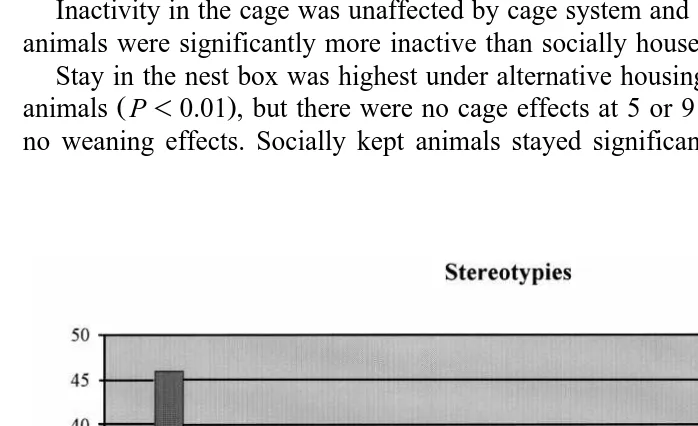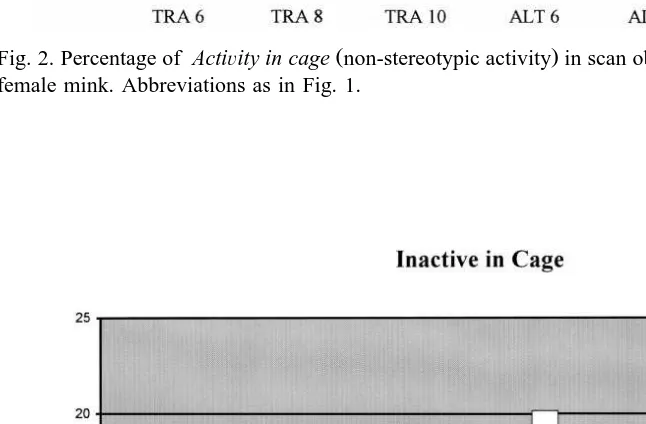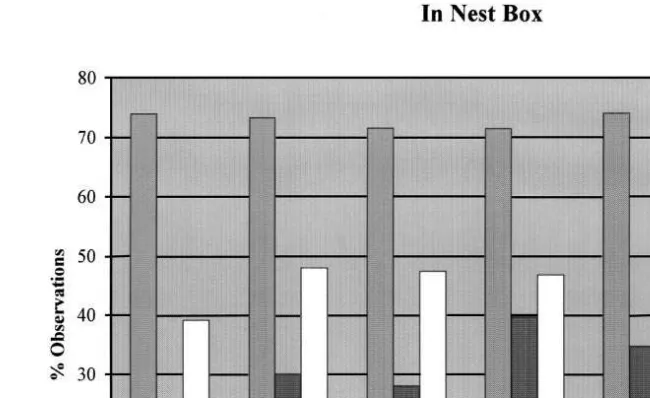www.elsevier.comrlocaterapplanim
Effects of early weaning and housing conditions on
the development of stereotypies in farmed mink
L.L. Jeppesen
), K.E. Heller, T. Dalsgaard
Zoological Institute, UniÕersity of Copenhagen, TagensÕej 16, DK-2200 Copenhagen, Denmark
Accepted 21 December 1999
Abstract
Female mink pups were weaned at 6, 8 or 10 weeks of age and subjected to two different housing conditions. They were either kept together with a single male sibling in traditional mink
Ž .
cages 30=45=90 cm or housed socially with all litter-mates in an alternative system
Ž .
consisting of three adjoining traditional cages 90=45=90 cm . All cages were supplied with nest boxes. At 5 months of age, the siblings were removed leaving the females socially isolated in the two different cage systems. Females’ stereotypies were quantified by repeated scanning observations under the social housing conditions immediately before removal of the siblings, and again at the age of 7 and 9 months, when the animals had stayed solitary in the two systems for 2 and 4 months. Solitary females showed significantly more stereotypies than females under social housing conditions in both cage systems. Stereotypies were more frequent in the smaller traditional cages. Stereotypies declined from 7 to 9 months of age among solitary animals in traditional cages but not in alternative cages. Early-weaned solitary females in traditional cages showed more stereotypies than later-weaned animals, but only when measured at the age of 7 months. It is suggested that early weaning, individual housing and small cages promote the development of stereotypies in farmed mink. The influence of early weaning on stereotypies seems to decline with age, while effects related to individual housing and small cages appear to be more persistent.q2000 Elsevier Science B.V. All rights reserved.
Keywords: Weaning age; Social housing; Cage size; Stereotypies; Mink
1. Introduction
In the wild, mother–infant separation is normally a gradual process, which involves short-lasting and intermittent episodes of conflict between the adult and the young until
)Corresponding author. Tel.:q45-3532-1304; fax:q45-3532-1299.
Ž .
E-mail address: [email protected] L.L. Jeppesen .
0168-1591r00r$ - see front matterq2000 Elsevier Science B.V. All rights reserved. Ž .
mutual independence is fully achieved. Conflicts during the weaning process have been reported to affect both the mother and her offspring aversively in a variety of mammal
Ž
species Seay et al., 1962; Schneirla et al., 1963; Fuller, 1967; Levine, 1967; Hinde and Spencer-Boot, 1971; Scott et al., 1974; Heller et al., 1988; Wurbel and Stauffacher,
¨
.
1997 . Compared with the transient nature of normal mother–infant separation, artificial weaning as in modern husbandry often occurs much more abruptly and at a considerably earlier age of the offspring, and this may result in long-lasting or even permanent
Ž .
negative influences on the offspring Fraser and Broom, 1990 .
Ž .
Mink pups Mustela Õison in nature make their first trips outside the den at 6–7
weeks of age, and increasing violent rejections by the mother has been observed when
Ž .
the pups are 10–12 weeks old Dunstone, 1993 . Under farm conditions, artificial weaning is conventionally imposed when the pups are 6–8 weeks old. At this age, the pups are no longer dependent on milk from their mother and they will easily eat solid food. Early-weaned mink pups, however, are more likely than late-weaned pups to develop permanent abnormalities especially in behaviour. These include higher
frequen-Ž cies of stereotypies and self-mutilating behaviour like tail-biting in adulthood Mason,
. 1994, 1996; de Jonge, 1996; Nimon, 1997 .
In addition to the influence of age of mother–infant separation, behavioural develop-ment and expression seem dependent on the housing conditions under which the animals
Ž .
are kept after separation from their mothers Mason, 1993, Cooper et al., 1996 . Individually raised mink pups have been reported to develop abnormal behaviour more
Ž .
easily than group-housed pups Hansen and Damgaard, 1991; Erlebach, 1993 , and differences in behaviour related to cage size and environmental enrichment have also
Ž .
been indicated reviewed by Nimon, 1997 . It is important to emphasise, however, that many contradictory results have been obtained and that many observations relate to very small samples or measurements that are not easy to interpret.
The environmental factors that initially determine the development of abnormal behaviour may be different from the factors that trigger or maintain already developed
¨
Ž
behavioural abnormalities later in life Fentress, 1976; 1977; Odberg, 1978; Mason, .
1991 . This implies that the housing systems and other environmental conditions like group housing or visual isolation after the weaning period may modify early weaning effects on later behaviour.
Ž .
The aims of the present study were to 1 relate weaning age to mink pups behaviour Ž . at 5 months of age when the animals have been housed socially with siblings; 2 relate weaning age to behaviour at 7 and 9 months of age under individual housing conditions;
Ž .
and 3 investigate the effects of different cage size on behavioural development with special emphasis on stereotypies.
Weaning ages and ages at behavioural observations were determined according to
Ž .
previous study procedures and standard management practise Heller et al., 1988 .
2. Animals, materials and methods
Ž .
The 141 focal animals were randomly assigned to six different experimental groups. There were two different housing conditions: either a traditional cage measuring
2 Ž .
30=45=90 cm supplied with a 0.27 m nest box ns64 or an alternative cage system representing three adjoining of the above mentioned cages with holes in the inner
Ž .
separations for free access between the three departments ns77 ; and there were three
Ž . Ž .
different weaning ages: weaning at 6 weeks ns49 , 8 weeks ns45 or 10 weeks Žns47 ..
Weaning was performed by removing the mothers to a different farm section leaving the focal female pup together with a male sibling under the traditional housing condition
Ž .
or the whole litter three to seven pups together under the alternative condition. The two different cage systems were placed alternately in traditional four-row mink sheds with visual isolation between neighbouring cages.
2.1. BehaÕiour at 5 months of age
Five months after weaning, focal females were each subjected to 56 visual scanning observations with 20-min intervals during 3 consecutive days. Scannings were per-formed during the light hours, and feeding was postponed to after termination of the daily observations. During the observations the following behavioural parameters were recorded:
Ž .
Stereotypies: occurrence of stereotypies Bildsøe et al., 1991; Mason, 1993 . ActiÕity in cage: non-stereotypic activity in cage.
InactiÕity in cage.
In nest box.
2.2. BehaÕiour at 7 and 9 months of age
After the above-mentioned behavioural recordings, all siblings were removed from the focal animals leaving them individually housed in both cage systems.
Two and four months later, the focal animals were each subjected to 15 scannings during a single day. Behavioural parameters were recorded as in Section 2.1. The number of observations was reduced in these periods due to considerably higher frequencies of stereotypies.
2.3. Statistical analysis
3. Results
Figs. 1–4 summarise the results for the four behavioural parameters recorded. Solitary animals showed significantly higher frequencies of stereotypies than animals
Ž .
under social housing conditions P-0.01 . Independent of social housing and age, Ž
stereotypies were recorded more frequently P-0.03 at 5 months; P-0.0001 at 7 .
months; P-0.003 at 9 months in the traditional housing system. Significant effects of weaning age were apparent in 7-month-old solitary animals under traditional housing
Ž .
conditions P-0.01 with early-weaned showing more stereotypies than later-weaned animals. Stereotypies declined with age among solitary kept animals under traditional
Ž .
housing conditions P-0.05 but not under alternative housing.
Normal activity in cage was highest under alternative housing conditions when
Ž . Ž .
measured among solitary animals at 7 P-0.001 and 9 P-0.002 months of age, but there was no effect of cage system at 5 months of age when the animals were kept socially. No significant effects of weaning age were shown, but there was a significant
Ž .
decline in normal activity with age P-0.01 .
Inactivity in the cage was unaffected by cage system and age at weaning, but solitary
Ž .
animals were significantly more inactive than socially housed animals P-0.01 . Stay in the nest box was highest under alternative housing conditions in 7-month-old
Ž .
animals P-0.01 , but there were no cage effects at 5 or 9 months of age. There were no weaning effects. Socially kept animals stayed significantly more in the nest boxes
Ž .
Fig. 2. Percentage of ActiÕity in cage non-stereotypic activity in scan observations on 5-, 7- and 9-month-old
female mink. Abbreviations as in Fig. 1.
Fig. 3. Percentages of InactiÕity in cage in scan observations on 5-, 7- and 9-month-old female mink.
Fig. 4. Percentages of In nest box in scan observations on 5-, 7- and 9-month-old female mink. Abbreviations as in Fig. 1.
Ž .
than solitary animals P-0.01 , and among solitary animals stay in the nest box
Ž .
increased with age P-0.01 .
4. Discussion
The present study shows that age at artificial weaning and housing conditions may have prolonged effects on mink behaviour. At 5 months of age when the animals were still housed socially with siblings, differences in age at weaning did not appear to affect behaviour, but levels of stereotypies were higher in the smaller and traditional cages. Other recorded behavioural parameters were unaffected by the type of cage system at that age. At 7 months, when the animals had been individually housed for 2 months, early-weaned animals showed more stereotypies than later-weaned animals under tradi-tional housing conditions but not under alternative housing. At the same age, stereotypy levels were again higher in the smaller and traditional cages, whereas normal activity and stay in nest boxes were more pronounced under alternative housing conditions. Effects of weaning age on stereotypies and normal activity declined when the animals were 9 months old and still kept solitary, but the effects of cage size on both stereotypies and normal activity were shown to continue. This is partly in agreement with the study
Ž .
by Mason 1996 . She found significantly higher frequencies of stereotypies among
Ž . Ž .
Behavioural differences between the three different age groups are difficult to interpret. At 5 months of age, levels of stereotypies and inactivity in the cages were considerably lower than in older mink, whereas normal activity and stay in nest boxes were recorded more frequently. This could of course be due to an influence of age, but the design in the present study does not allow discrimination between age effects and effects related to social housing conditions at that age. Behavioural differences between solitary kept 7- and 9-month-old mink are easier to deal with, and here we clearly demonstrate that stereotypy facilitating effects of early weaning decline among solitary and traditionally kept animals between the age of 7 and 9 months. Moreover, normal activity declines with age, whereas stay in the nest boxes increases. Observations on 9-month-old females were carried out in February before the mating season in March. It cannot be ruled out, however, that onset of the period of heat may have affected behaviour at that age.
Because adult mink in nature generally avoid each other and are extremely territorial Že.g. Dunstone, 1993 , there has been much debate about the appropriate social housing.
Ž .
for mink under farm conditions. Hansen and Damgaard 1991 found higher cortisol levels in individually housed than in group-housed females, indicating higher levels of
Ž .
experienced stress among individually housed females. Møller 1991 showed that individually housed mink have lower weight gain than mink housed in pairs, and
Ž .
Erlebach 1993 reports that stereotypies develop earlier in individually housed mink than in those housed in groups of three. In all these studies, the different housing conditions were established from the time of weaning.
The extremely low stereotypy levels among 5-month-old females housed socially since birth in the present study could be due to age as mentioned above, but we suggest that the influence of the social milieu play a more important role. If so, the present results support the findings of the above-mentioned studies and add that individually housing of adult females may promote development of stereotypies even if the females have previous experience with socially housing since birth and until the age of 5 months. The present findings of significantly higher stereotypy levels in traditional cages compared to the levels in larger cages suggest that also cage size may affect the
Ž .
development of stereotypies. This is in contrast to the study of Hansen 1988 who found no differences between stereotypy levels among mink housed in three different
Ž .
cage sizes. In the study by Hansen 1988 , however, larger cages were undivided and the animals were kept in pairs with or without access to a single nest box. Alternatively housed mink in the present study had access to divided cages with three nest boxes. Thus, the larger cages here seem to represent a more enriched environment which may have added to the reducing effect of size on the development of stereotypies.
References
Bildsøe, M., Heller, K.E., Jeppesen, L.L., 1991. Effects of immobility stress and food restriction on stereotypies in low and high stereotyping female ranch mink. Behav. Processes 25, 179–189.
¨
Cooper, J.J., Odberg, F.O., Nicol, C.J., 1996. Limitations on the effectivenes of environmental improvement in
Ž .
de Jonge, G., 1996. A new housing system for mink. In: Proc. 6th Int. Sci. Congr. Fur Anim. Prod., Warzawa. pp. 45–51.
Dunstone, N., 1993. The Mink. T&AD Poyser, London.
Erlebach, S., 1993. Effects of environment on the behaviour of mink. In: Nichelmann, M., Wierenga, H.K.,
Ž .
Baun, S. Eds. , Proceedings of the International Congress on Applied Ethology. Humbolt University, Berlin, pp. 108–112.
Fentress, J.C., 1976. Dynamic boundaries of patterned behaviour: interaction and self-organization. In:
Ž .
Bateson, P.P.G., Hinde, R.A. Eds. , Growing Points in Ethology. Cambridge Univ. Press, Cambridge, pp. 135–167.
Fentress, J.C., 1977. The tonic hypothesis and the patterning of behaviour. Ann. N. Y. Acad. Sci. 290, 370–395.
Fraser, A.E, Broom, D.M., 1990. Farm Animal Behaviour and Welfare. 3rd edn. Baillier Tindal, London. Fuller, J.L., 1967. Experiental deprivation and later behavior. Science 158, 1645–1652.
Hansen, S.W., 1988. Effect of variable cage size and lack of admission to nestbox on the behaviour,
Ž .
physiology and production of mink kits. In: Murphy, B.D., Hunter, D.B. Eds. , Biology, Pathology and Genetics of Fur-Bearing Animals. Unpublished Proceedings of the Vth International Scientific Congress on Fur Animal Production, Toronto.
Hansen, S.W., Damgaard, B.M., 1991. Stress physiological, hemathological, and clinical–chemical status of farm mink placed in groups or singly. Acta Agric. Scand. 41, 355–366.
Heller, K.E., Houbak, B., Jeppesen, L.L., 1988. Stress during mother–infant separation in ranch mink. Behav. Processes 17, 217–227.
Hinde, R.A., Spencer-Boot, Y., 1971. Effects of brief separation from mother on rhesus monkeys. Science 773, 111–118.
Levine, S., 1967. Maternal and environmental influences on the adrenocortical response to stress in weanling rats. Science 157, 258–260.
Mason, G.J., 1991. Stereotypies: a critical review. Anim. Behav. 41, 1015–1037.
Mason, G.J., 1993. Age and context affect the stereotypies of caged mink. Behaviour 127, 191–229.
Ž .
Mason, G.J., 1994. Tail-biting in mink MustelaÕison is influenced by age at the removal from mother.
Anim. Welfare 3, 305–311.
Mason, G.J., 1996. Early weaning enhances later development of stereotypy in mink. In: Duncan, I.J.H.,
Ž .
Widowski, T., Haley, D.B. Eds. , Proceedings of the 30th International Congress of the International Society for Applied Ethology. p. 16.
Møller, S., 1991. Weight gain and hair chewing in mink kits placed singly or in pairs from September. Scientifur 15, 21–27.
Nimon, A.J., 1997. The welfare of farmed mink and foxes in relation to housing and management. Report from Cambridge University Animal Welfare Information Centre, Cambridge.
¨ Ž . Ž .
Odberg, F.O., 1978. Abnormal behaviours stereotypies , introduction to the round table. In: Garsi Ed. , Proc. 1st World Congr. Ethol. Appl. Zootech.. Industrias Graficas, Espana, pp. 475–480.
Ž .
Schneirla, T.C., Rosenblatt, J.S., Tobach, E.R., 1963. Maternal behavior in the cat. In: Rheingold, H.L. Ed. , Maternal Behavior in Mammals. Wiley, New York, pp. 122–168.
Scott, J.P., Stewart, J.M., 1974. Critical periods in the organization of systems. Dev. Psychobiol. 7, 489–513. Seay, B., Hansen, E., Harlow, H.F., 1962. Mother–infant separation in monkeys. J. Child. Psychol. Psychiatry
3, 123–132.
Siegel, S., Castellan, N.J., 1988. Nonparametric Statistics for the Behavioral Sciences. McGraw-Hill, New York.


